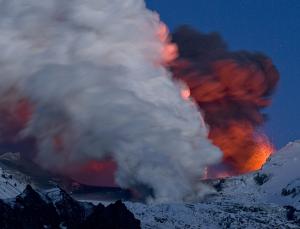 |
| Reviews and Templates for Expression We |
Melting ice spells volcanic trouble
Melting ice is causing the land to rise up in Iceland – and perhaps elsewhere. The result, judging by new findings on the floor of the Southern Ocean, could be a dramatic surge in volcanic eruptions
.
Melting glaciers could lead to volcanic eruptions (Image: Image Broker/REX)
Last week, researchers at the University of Arizona in Tucson showed that a recent dramatic uplift of the Earth's crust in parts of Iceland coincided with the rapid melting of nearby glaciers.
Kathleen Compton's team used data from GPS receivers that have been attached to rocks since 1995 to show that some parts of south-central Iceland, where five of the country's largest glaciers are melting fast, have been rising by around 3.5 centimetres a year. Away from the glaciers, the rates of land rise were much lower.
Their explanation is that the disappearance of the ice is relieving pressure on rocks beneath and allowing them to spring up.
Rapid rebound
It has long been known that the Earth's crust falls and rises as ice caps grow and melt. But the speed of the rebound is surprising, says Compton.
Richard Katz of the University of Oxford finds the discovery "very exciting". "The measurements show that there is a response even at a very short time-scale of 30 years," he says.
The land uplift could be handy to protect some coastal areas from rising sea levels as the melting ice flows into the oceans. But there is a growing fear among geologists that climate-induced changes to water and ice levels could trigger more dangerous events, such as volcanic eruptions.
The evidence is mostly from the past. For instance, during the last great melt 12,000 years ago, volcanic activity on Iceland was up to 50 times greater than the activity observed over the past century, says Bill McGuire, a volcanologist at University College London. Iceland has suffered three major volcanic eruptions in the past five years – although no one has shown a certain link with climate change.
Seabed clue
And today, fresh evidence of climatic cues for volcanic eruptions emerges from an analysis of thousands of kilometres of ridges on the floor of the Southern Ocean. The ridges were created by huge eruptions.
Through detailed analysis of the topography of the seabed, John Crowley of the University of Oxford shows that the eruptions coincided with phases of orbital wobbles known as Milankovitch cycles, which trigger ice ages.
He concludes that glaciations caused the increase in eruptions. By locking up much of the world's water in ice sheets on land, they lowered sea levels and so reduced the ocean's pressure on the seabed enough to allow magma to escape from the Earth's mantle. "Our work reinforces the link between climate change and volcanism," says Katz, a co-author of the Crowley paper.
So it seems that glaciation can trigger submarine eruptions, while deglaciation may lead to magma outflows on land.
"Both these studies reinforce the idea that the wholesale redistribution of water that accompanies major climate change elicits a significant response from the solid earth in the form of potentially hazardous phenomena such as earthquakes and volcanic eruptions," says McGuire. "We saw this very dramatically at the end of the last ice age, and we are seeing it again today in Iceland and elsewhere."
|
|
|
|
Copyright 2011 Energy and Technical Services Ltd. All Rights Reserved. Energyts.com |